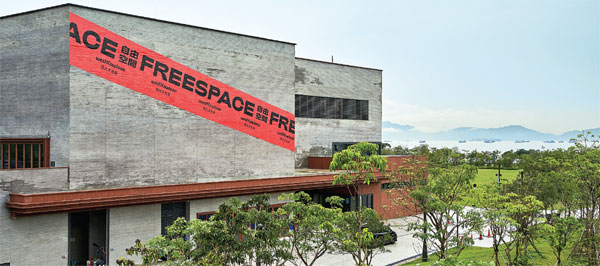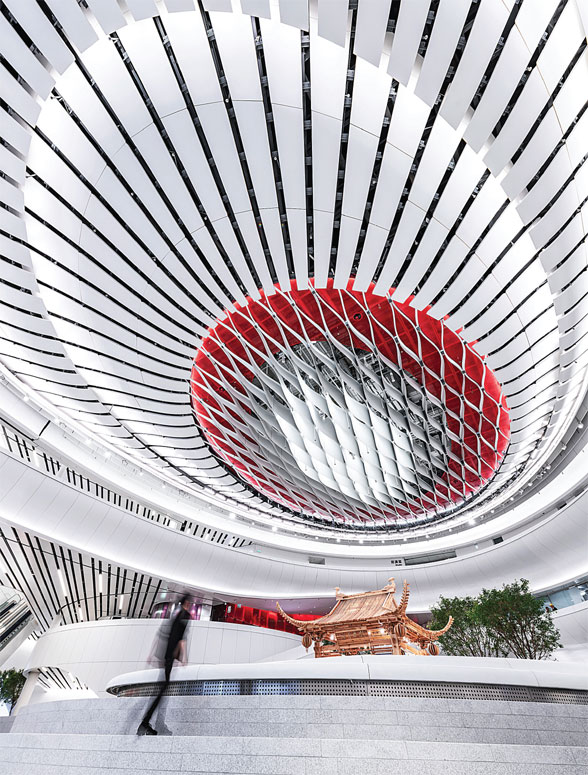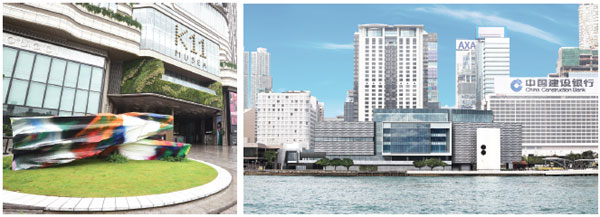Skyline art
Updated: 2019-10-18 07:39
By Rebecca Lo(HK Edition)
|
|||||||||
Rapidly evolving into the city's new cultural nerve center, south Kowloon is now dotted with an eclectic array of distinctive architecture, writes Rebecca Lo.
The last week of August this year witnessed a flurry of activity as K11 Musea completed final touches prior to opening its doors to the public. The 10-story homage to art and culture was the final piece of the Victoria Dockside jigsaw puzzle from New World Development's Executive Vice-chairman and General Manager Adrian Cheng.
Like its predecessor, New World Centre, Victoria Dockside is a mixed-use complex. Yet it rackets up the cultural component with architecture by New York-based KPF, assisted by local firm Ronald Lu & Partners (RLP).
|
Freespace, West Kowloon Cultural District's multi-venue performance art space, affords an uninterrupted view of the waterfront. Photos provided to China Daily |
|
Xiqu Centre, a purpose-built facility dedicated to Chinese opera, was designed by the Canadian architect Bing Thom. The project was executed with support from Hong Kong's own Ronald Lu & Partners. |
"Victoria Dockside is built upon the former New World Centre site, originally completed in the early 1980s and at one point regarded as one of the largest mixed-use complexes in the world," notes RLP vice chairman Bryant Lu. "Victoria Dockside is much more ambitious and comprehensive - uniting the skyline of Hong Kong and the iconic Victoria Harbour with a curated cultural and visual arts district. It will become a destination for a new generation that expects an experiential journey."
The complex encompasses one of the tallest buildings in Tsim Sha Tsui, with a silhouette reminiscent of the Willis Tower in Chicago. Within it is Rosewood Hong Kong, the hotel brand's flagship property helmed by Cheng's younger sister Sonia, with aesthetics courtesy of New York-based interior design guru Tony Chi. Another chunk of the tower is taken by premium office space, K11 Atelier, while a separate tower with curvilinear balustrades houses K11 Artus' luxury serviced apartments.
What sets Victoria Dockside apart is its high-quality materials and attention to detail. The project is billed as the culmination of Cheng's "Artisanal Movement" vision, launched with the Eight South Lane residences in 2013.
K11 Musea boasts a number of art and cultural firsts: Collaboration with more than 100 local and international designers including Rem Koolhaas and David Gianotten of OMA; a 6,000-square-foot Museum of Modern Art (MoMA) shop designed by Edge Design Institute's Gary Chang; a green-wall facade by PLandscape; and more than 40 pieces of public art and sculpture with many created specifically for the site.
Chang's inspiration for the first MoMA store in China and third in Asia came from Hong Kong itself: "We incorporated local elements in homage to our cultural heritage as part of the aesthetical expression and tangible execution."
Examples include the use of bamboo and galvanized zinc, mobile chess-piece-like fixtures inspired by mahjong tables, and a revamped version of the dim sum trolley. "We hope such elements would evoke a sense of familiarity, while inspiring a greater collaboration between international creativity and local workmanship in Hong Kong," says Chang.
Public engagement
Despite the abundance of art in the public areas of Victoria Dockside, Hong Kong-based Italian urban designer Massimiliano Dappero of UrbanHack feels that there needs to be a balance between commerce and true public engagement.
"Victoria Harbour should be for everyone," Dappero states. "Does Victoria Dockside return a beautiful waterfront back to the city? To me, it's not that different from Harbour City."
He seems more impressed with the efforts made by Victoria Dockside's neighbor, Hong Kong Museum of Art (HKMoA), toward community outreach. "I feel what the Museum of Art is doing through its renovation scheme is more publicly engaging than Victoria Dockside."
Slated to open at the end of 2019, HKMoA is nearing the end of a four-year reboot that is expected to transform an inward-looking relic of the early 1990s into a museum that engages directly with the public. Its renovation by the Architectural Services Department (ASD) will boast 40 percent more exhibition space through five additional galleries. A new glass facade has been introduced to underscore the museum's more transparent mandate. A new annex block can display large-scale works. Galleries have been added on its extended roof floor.
"ASD used a textural material on the facade with movements that echo the harbor theme, resulting in a lively looking building when viewed from across the harbor," says Eve Tam, assistant director of special projects with the Leisure and Cultural Services Department and former museum director with HKMoA. "Previously, the building was very enclosed. Now, with Tsim Sha Tsui as its background, its new ground-level wing has glass sliding doors that engage the public by allowing them to see what's going on inside. The outdoor art corridor will echo the interior exhibits."
Tam feels that the renovated HKMoA offers a revitalized complement to the more contemporary architecture and offerings at nearby West Kowloon Cultural District's (WKCD) M+, designed by Basel-based architectural firm Herzog & de Meuron. "While M+ has an international collection of 20th and 21st century works, HKMoA (houses) a traditional Chinese collection," she explains.
"HKMoA has an excellent book collection, Chinese painting and calligraphy, and its Chinese trade art is very unique - one of the top three in the world. While M+ is development-focused, HKMoA takes a more systematic approach with a vertically historic narrative. I particularly like the new ground-floor gallery, with its high ceiling and skylight. The city can (look) into the museum while visitors can look out to the city."
West Kowloon calls
Although M+ will not be ready until late 2020, the opening of Xiqu Centre and Freespace in the past year has generated significant buzz for WKCD. Unveiled last December, Xiqu Centre was designed by the late Canadian architect Bing Thom with RLP as its local collaborating architect.
Freespace opened this June as WKCD's second major performing arts venue and features flexible theatre spaces, including one of the largest black-box theaters in the city. While Xiqu Centre focuses on Chinese Opera, Freespace is a venue-for-hire, open to staging theater, dance, music and any other performance art form.
"Xiqu Centre is the first contemporary platform showcasing Chinese opera in Hong Kong," says Lu. "Just a stone's throw away from each other, Xiqu Centre and Victoria Dockside are both new buildings complementing each other and the Kowloon skyline. Each has a silhouette that stands out and leaves unique impressions. Both are purposely designed with a covered public space. People can rest and treat these as a focal point of the community. Both designs aim to enhance people's interaction with the space, creating a cohesive community engagement for the area."
Dappero is eager to see how WKCD shapes up when all of its venues are up and running - and whether it will offer real public engagement as well as world-class architecture.
"For any space to engage, it needs to offer the public a multiple number of things to do," he states. "I hope that these can be more organic rather than dictated top down. The West Kowloon Station for the high-speed rail already brings a lot of visitors to the area. West Kowloon Cultural District is really our last chance to create an engaging waterfront for everyone."
|
Located within stone's throw of each other, K11 Musea, the city's new culture plus retail destination (left) and Hong Kong Museum of Art (right) are expected to set new benchmarks for community engagement. |
(HK Edition 10/18/2019 page1)


